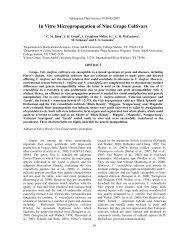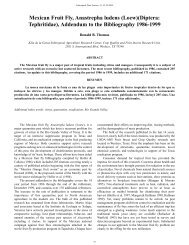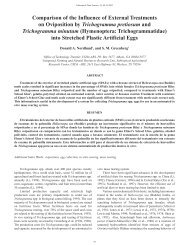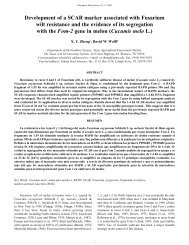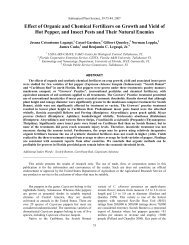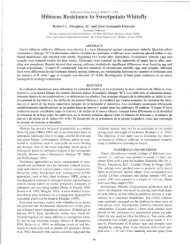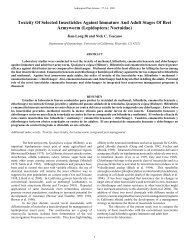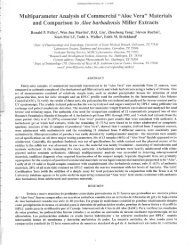Subtropical Plant Sci. J. 58:29-34. - Subtropical Plant Science Society
Subtropical Plant Sci. J. 58:29-34. - Subtropical Plant Science Society
Subtropical Plant Sci. J. 58:29-34. - Subtropical Plant Science Society
You also want an ePaper? Increase the reach of your titles
YUMPU automatically turns print PDFs into web optimized ePapers that Google loves.
<strong>Subtropical</strong> <strong>Plant</strong> <strong>Sci</strong>ence <strong>58</strong>:<strong>29</strong>-34 (2006).<br />
Table 2. Chi-square analyses for segregation of five RAPD markers and andromonoecious (a) associated with total soluble<br />
solids in two F 2 populations derived from melon crosses of ‘TAM Dulce’ x TGR1551 (TT) and ‘Deltex’ x TGR1551 (DT).<br />
TT plants (no.)<br />
DT plants (no.)<br />
Marker z Source Presence Absence Ratio χ 2 P Presence Absence Ratio χ 2 P<br />
OAW06.1250 TAM Dulce & Deltex 80 25 3:1 0.02 0.87 55 9 3:1 3.52 0.06<br />
OAT03.250 TAM Dulce & Deltex 75 30 3:1 0.53 0.46 44 20 3:1 1.01 0.31<br />
OAP03.800 TGR1551 & Deltex 81 24 3:1 0.15 0.69 3:1<br />
OAS03.450 TGR1551 70 35 3:1 3.45 0.06 41 23 3:1 3.52 0.06<br />
OAW06.600 TGR1551 & Deltex 80 25 3:1 0.02 0.87 3:1<br />
a TGR1551 74 31 3:1 0.91 0.34 45 19 3:1 0.52 0.47<br />
(monoecious)<br />
z No segregation of OAP03.800 and OAW06.600 in the DT F 2 population.<br />
(monoecious)<br />
(andromonoecious)<br />
(andromonoecious)<br />
for 4% to 7% of the TSS variation. The two unlinked makers from<br />
‘TAM Dulce’ and the three unlinked markers from TGR1551<br />
explaining 14% and 19% of the total phenotypic variation for the<br />
trait, respectively, were significant in the stepwise multiple<br />
regression analysis (Table 3).<br />
RAPD markers linked to quantitative genes for fruit size<br />
and shape traits as well as qualitative genes for pest and disease<br />
resistance have been detected successfully by bulked segregant<br />
analysis in melons (Klingler et al., 2001; Morales et al., 2002; Park<br />
and Crosby, 2004; Wechter et al., 1995). In tomato, peach, and<br />
watermelon one to two major QTL influencing soluble solids<br />
content were observed by several investigators (Causse et al., 2002;<br />
Etienne et al., 2002; Georgelis et al., 2004; Hashizume et al., 2003),<br />
while seven minor QTL related to the TSS content in tomato were<br />
found by Paterson et al. (1991). This is the first report of molecular<br />
markers associated with QTL affecting TSS in melon using bulked<br />
segregant analysis. These RAPD markers and the andromonoecious<br />
trait associated with the TSS QTL could be useful to transfer these<br />
genes into a low sugar cultivar or breeding line to enhance the<br />
mature melon fruit sweetness.<br />
Confirmation of QTL. The associations of the RAPD<br />
and andromonoecious markers with QTL for the fruit sweetness<br />
trait identified in the F 2 population of the ‘TAM Dulce’ x TGR1551<br />
cross in the greenhouse needed to be continued in other populations<br />
of the same cross and or a different cross in different environments<br />
to substantiate their merit in melon breeding. Of the five RAPD<br />
markers associated with the fruit sweetness trait detected in the<br />
greenhouse population, three were also polymorphic between the<br />
parents ‘Deltex’ and TGR1551, utilized to create the F 2 population<br />
from which the fruit sweetness trait was evaluated in the field<br />
experiment (Table 2). Due to no segregation of OAP03.800 and<br />
OAW06.600 in the parents ‘Deltex’ and TGR1551, the remaining<br />
two markers were not tested for confirming the marker-QTL<br />
association. All three markers also segregated in the F 2 population<br />
of the ‘Deltex’ x TGR1551 cross. A 3:1 goodness-of-fit ratio for<br />
band presence to band absence for each of the three markers, two<br />
amplified from ‘Deltex’ and one amplified from TGR1551, was<br />
observed in the field population (Table 2).<br />
Two RAPD markers associated with the fruit sweetness<br />
trait in the greenhouse experiment were confirmed in the F 2<br />
population of the ‘Deltex’ x TGR1551 cross in the field experiment<br />
to be consistently associated with QTL for the sweetness trait<br />
Table 3. Simple linear regression (SLR) and stepwise multiple regression (SMR) analyses of marker and data for<br />
detection of QTL for total soluble solids in an F 2 population derived from the melon cross of ‘TAM Dulce’ (high<br />
total soluble solids) x TGR1551 (low total soluble solids) in the greenhouse experiment.<br />
SLR Average value SMR<br />
RAPD marker Source P R 2 (%) Presence Absence P R 2 (%)<br />
OAW06.1250 TAM Dulce 0.001 9 6.8 z 5.2 y 0.001 9<br />
OAT03.250 TAM Dulce 0.0<strong>29</strong> 5 6.7 5.7 0.014 5<br />
Cumulative R 2 = 14<br />
OAS03.450 TGR1551 0.004 8 6.1 7.0 0.004 8<br />
OAP03.800 TGR1551 0.005 7 6.1 7.5 0.011 6<br />
OAW06.600 TGR1551 0.010 6 6.1 7.3 0.011 5<br />
a x TGR1551 0.044 4 6.2 7.1<br />
Cumulative R 2 = 19<br />
z An average value of F 2 plants with band presence for the marker.<br />
y<br />
An average value of F 2 plants with band absence for the marker.<br />
x Andromonoecious.<br />
32



